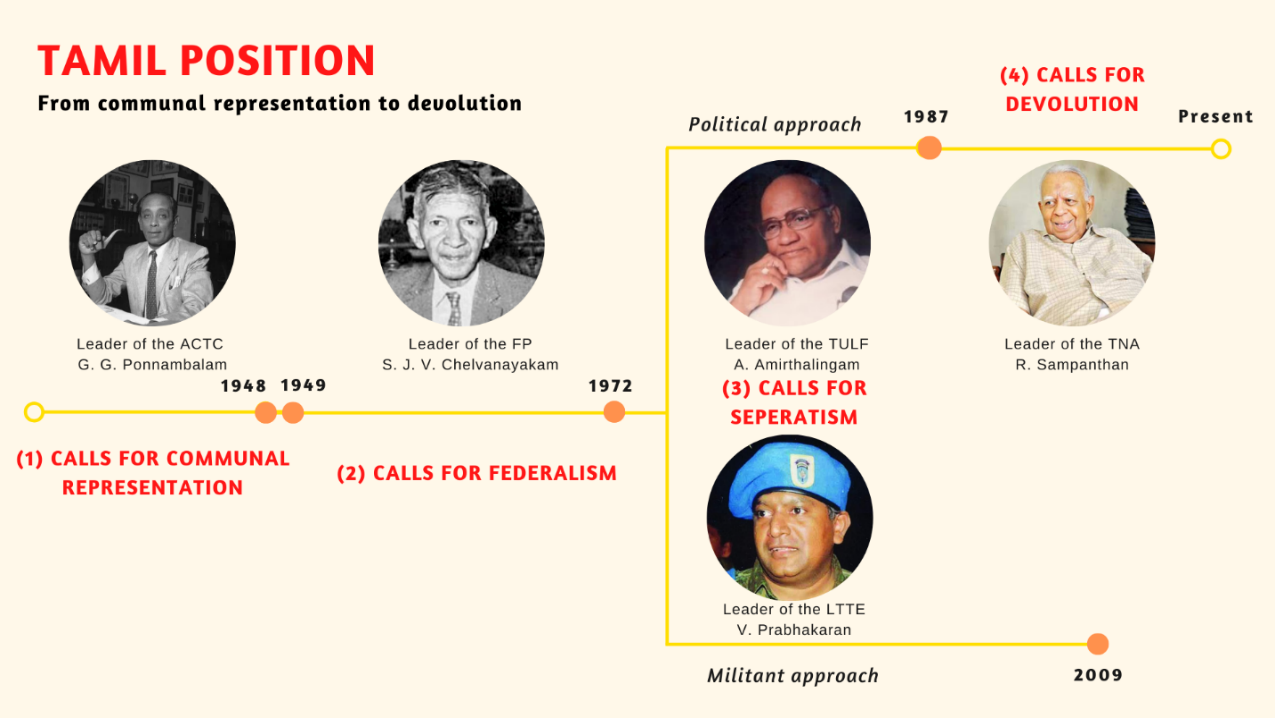Abstract
Federalism is broadly defined as a political system in which power is shared between a central government and state governments. However, federalism has come to mean two different things to Sri Lankans. As such, the following article traces the evolution of the concept of federalism among the Sinhalese and Tamils of Sri Lanka.
Introduction
Federalism is broadly defined as a political system in which power is shared between a central government and state governments. However, federalism has come to mean two different things to Sri Lankans. Most Sinhalese view federalism as a precursor to dividing the country and therefore a threat to Sri Lanka’s unitary status. Most Tamils view federalism as a means of achieving autonomy. Yet, nearly a century ago, their attitudes towards federalism were different. Some Sinhalese championed federalism, while some Tamils sought a solution outside federalism. This article traces the trajectories of Sinhalese and Tamil positions on federalism. It is presented in two parts. First, it traces the Sinhalese position, and second, it traces the Tamil position.
The Sinhalese Position
Over the last century, some Sinhalese went from championing federalism to offering only concessionary devolution. The Sinhalese position can be traced along two periods.

1. Championing federalism
Before independence, some Sinhalese leaders championed federalism. Under British rule, the Sinhalese aspired to achieve autonomy. In this context, two proponents of federalism emerged in the 1920s.
First, Kandyan Sinhalese demanded a federal state. The Kandyan National Assembly appearing before the Donoughmore Commission proposed: ‘Ceylon should be divided into three self-governing states, under a central federal government’ (Colonial Office, 1945).
Second, S.W.R.D. Bandaranaike espoused the idea of federalism. In 1926, Bandaranaike published six articles in the Ceylon Morning Leader, promoting an ‘internal federation’. Bandaranaike also delivered a lecture in Jaffna proposing: ‘in Ceylon, each province should have complete autonomy’ (de Mel and Pathmalal, 2009).
The concept of federalism continued to resonate with the Sinhalese in the 1930s and 1940s (Aluvihare, 1941; Wettimuny, 2020; Ceylon Communist Party, 1944). In 1944, the Sinhalese reiterated their calls for federalism before the Soulbury Commission. However, it was dismissed, and the commission recommended a unitary constitution for the country.
2. Concessionary devolution
Following independence, successive Sinhalese governments introduced policies along ethnoreligious lines. In 1956, the government passed the Official Language Act, which made Sinhala the country’s sole official language. Similarly, it promoted Sinhalese colonisation of Tamil regions. The Sinhalese perceived these policies as ‘correcting’ historical injustices they endured under colonial rule.
The Tamils strongly opposed these majoritarian policies. To appease the Tamils, the Sinhalese-led government proposed devolution as a concession. The 1957 Bandaranaike-Chelvanayagam Pact and the 1965 Senanayake-Chelvanayagam Pact sought to devolve power to regions, including to the North and East, which is the historical homeland of the Tamils. Yet, the pacts were abandoned following Sinhalese resistance. For instance, the Bandaranaike-Chelvanayagam Pact sparked several violent protests and eventually led to the assassination of Bandaranaike by a Buddhist monk.
The failure to accommodate Tamil demands for federalism eventually manifested into calls for separatism.
The Sinhalese adopted two approaches to counter separatism. First, the government adopted a military approach to combat Tamil militancy. The military approach ended in 2009 with the defeat of the Liberation Tigers of Tamil Eelam (LTTE), the main militant group that fought for a separate state.
Second, successive Sinhalese governments adopted a political approach, that is, offering limited devolution as a means of countering separatism. In 1987, President J.R. Jayawardena signed the Indo-Lanka Accord to establish provincial councils. During the Norway-mediated ceasefire in 2002, the government and the LTTE agreed to ‘explore a solution founded on the principle of internal self-determination’ (Government of Norway, 2002). The governments that came into power following the defeat of the LTTE, also pledged to devolve power. For instance, Mahinda Rajapaksa and Maithripala Sirisena promised to fully implement the 13th Amendment (13A).
Within the Sinhalese community, the growing misconception that federalism is synonymous with separatism has led to its rejection. For instance, some segments of the Sinhalese community view federalism as a pre-cursor to dividing the country. The negative attitude towards devolution intensified following Gotabaya Rajapaksa’s election in November 2019. Some members of the current government including Minister of Public Security (former Minister of Provincial Councils) Sarath Weerasekera and the Secretary to the Ministry of Foreign Affairs Jayanth Colombage call for the concentration of power in the central government (Farzan, 20201; Srinivasan 2021).
The Tamil Position
Over the last century, Tamils went from demanding equal communal representation in the central government to demanding devolution of power. Often, Tamil demands evolved in response to various governments’ ethno-religious policies. The Tamil position on autonomy can be traced along four phases.

1. Calls for communal representation
Under British rule, Tamils were perceived to have enjoyed relative socio-economic prosperity in relation to the Sinhalese. In this context, Tamils aspired to secure equal communal representation within a unitary state. Hence, some Tamils, including James Rutnam, rejected Sinhalese calls for federalism stating that, it will ‘create disunity in Ceylon’ (Jeyaraj, 2019).
Instead, Tamil leaders including G.G. Ponnambalam (the leader of the All Ceylon Tamil Congress (ACTC)), proposed a ‘fifty-fifty’ arrangement for power sharing (Ponnambalam, 2001). However, Ponnambalam’s proposal was opposed by the Sinhalese and the Soulbury Commission.
2. Calls for federalism
Following independence, Tamils viewed the successive Sinhalese government’s ethno-religious policies as discriminatory. The Ceylon Citizenship Act of 1948 disenfranchised nearly 780,000 Tamils of Indian origin. Similarly, the government promoted Sinhalese colonisation of pre-dominantly Tamil areas (Kanagasundaram, 2016; Veluppillai, 2012).
As a response, a group led by S.J.V. Chelvanayagam formed the Federal Party (FP) in 1949. The FP advanced several objectives, including the creation of a federal union, and ending state-sponsored colonisation of Tamil regions (Rajasingham, 2019). In 1951, the party formally demanded a federal state (Tamil National Alliance, 2015).
Despite these demands, the state continued to formulate discriminatory policies. The Tamils viewed the 1956 Official Language Act, which made Sinhala the sole official language, and the 1971 Policy of Standardisation that curtailed the number of Tamil students entering university as marginalising them. Moreover, Tamils faced periodic mob violence in 1956, 1958, and 1961 (Tamil National Alliance, 2015).
3. Calls for separatism
The enactment of the 1972 constitution was a catalyst for Tamil demands for separatism. The 1972 constitution granted the foremost place for Buddhism and reaffirmed Sinhala as the only official language (Constitution of Sri Lanka, 1972). Tamils embarked on two approaches to demand separatism.
Some Tamils employed a political approach to call for a separate state. Following the enactment of the constitution, the FP and the ACTC jointly formed the TULF. In 1976, the party adopted the ‘Vaddukoddai Resolution’, which called for the creation of a ‘free, sovereign, secular socialist state of Tamil Eelam’ (Tamil United Liberation Front, 1976). During the 1977 election, the TULF led by Appapillai Amirthalingam campaigned on a platform for the creation of a separate Tamil Eelam and secured overwhelming support within Tamil regions. However, in 1983, all TULF MPs forfeited their parliament seats having refused to renounce a separate state as required by the Sixth Amendment.
Concurrently, some Tamils employed a militant approach to demand Eelam. From among the Tamil militant groups that emerged in the seventies, the LTTE arose as the strongest and most brutal group and often resorted to terrorist tactics. The LTTE fought for Eelam till their defeat in 2009.
4. Calls for devolution
The intensifying conflict between the state and the LTTE, paved way for Indian mediation. The Indo-Lanka Accord envisaged devolution through the establishment of provincial councils. After its establishment, the TULF abandoned calls for separatism. In 1989, the TULF re-entered parliament and swore an oath of allegiance against separatism.
The TULF’s demands for devolution were overshadowed by the escalation of armed conflict between the state and the LTTE. However, following the LTTE’s defeat, the Tamil National Alliance (TNA), advocated regional self-rule through a devolution mechanism within a united Sri Lanka (The Guardian, 2010). As such, the TNA currently demands ‘meaningful power sharing arrangements.’
Conclusion
Federalism as a concept has two conceptions in Sri Lanka. On the one hand, both the Sinhalese and Tamils subscribed to a positive conception of federalism, but at separate points in Sri Lanka’s history. The Sinhalese championed federalism before independence while Tamils demanded federalism after independence. The Tamil demands for federalism evolved in response to Sinhalese-led governments’ ethno-religious policies. On the other hand, a segment of the Sinhalese community subscribed to a negative conception of federalism. They view federalism as a prelude to dividing the country. Such misconceptions have led to renewed calls for the repealing of the Thirteenth Amendment. Thus, Tamil demands for federalism and Sinhalese resistance to federalism may potentially exacerbate fault lines in Sri Lankan society.
Canagasabey, R. 2021. ‘‘Federalism in Sri Lanka: One Concept, Two Conceptions?’, 50 Shades of Federalism.
Bibliography
Aluvihare, B.H, 1941, ‘The Kandyan Convention and After’, pp. 1-44. Available at: https://bit.ly/37nXhtN [last accessed 29 March 2021].
Ceylon Communist Party, 1944, ‘Ceylon Communist Party’s Resolutions and Memoranda on Federalism and Self-Determination’. Available at: https://bit.ly/2OBznnZ [last accessed 29 March 2021].
Colonial Office, 1945, ‘Report of the Commission on Constitutional Reforms’, pp. 56. Available at: https://bit.ly/3s3v83a [last accessed 29 March 2021].
Constitution of Sri Lanka, 1972, ‘Constitution of Sri Lanka (Ceylon), Parliament of Sri Lanka, Available at: https://www.parliament.lk/files/ca/4.%20The%20Constitution%20of%20Sri%20Lanka%20%20-%20%201972%20(Article%20105%20%E2%80%93134)%20Chapter%20XIII.pdf [last accessed 29 March 2021].
De Mel, D & Pathmalal, S.L, 2009, ‘Political and Economic Policy Priorities in Supporting Post Conflict Peace and Development in Sri Lanka’, World Bank, pp. 16. Available at: https://web.worldbank.org/archive/website01241/WEB/IMAGES/SRILANKA.PDF [last accessed 29 March 2021].
Farzan, Z, 2020, ‘No 13th Amendment or Provincial Councils; Rear Admiral Sarath Weerasekera’, News First. Available at: https://bit.ly/3prrRJ1 [last accessed 29 March 2021].
Government of Norway, 2002, ‘Breakthrough in Sri Lanka peace negotiations’. Available at: https://bit.ly/3bhe4zF [last accessed 29 March 2021].
Jeyaraj, D.B.S, 2019, ‘S.W.R.D. Bandaranaike: Sri Lanka’s pioneering proponent of federalism’, Daily Mirror. Available at: https://bit.ly/3djq2vu [last accessed 29 March 2021].
Kanagasundaram, A, 2016, ‘The Gal Oya Project 60 years on’. Available at: https://ceylon-ananda.com/the-gal-oya-project-60-years-on-part-ii/ [last accessed 29 March 2021].
Ponnambalam, G.G, 2001, ‘The Marathon Crusade for Fifty-Fifty’, Manimekali Prasuram. Available at: https://bit.ly/2Zsw9Fw [last accessed 29 March 2021].
Rajasingham, K.T, 2019, ‘Sri Lanka: The Untold Story’, Ilankai Tamil Sangam. Available at: https://bit.ly/3ppudIp [last accessed 29 March 2021].
Srinivasan, M, 2021, ‘India cannot abandon us: Sri Lanka’, The Hindu. Available at: https://www.thehindu.com/news/international/india-cannot-abandon-us-sri-lanka/article33944062.ece [last accessed 29 March 2021].
Tamil United Liberation Front, 1976, ‘Vaddukoddai Resolution’, Ilankai Tamil Sangam. Available at: https://bit.ly/37q8v0K [last accessed 29 March 2021].
The Guardian, 2010, ‘Sri Lankan Tamil alliance drops independence demand’. Available at: https://www.theguardian.com/world/2010/mar/14/sri-lanka-tamils-self-rule [last accessed 29 March 2021].
Veluppillai, T, 2012, ‘Systematic Colonization of the Northern and Eastern Provinces’, Ilankai Tamil Sangam. Available at: https://bit.ly/2ZppITN [last accessed 29 March 2021].
Wettimuny, S, 2020, ‘Pre-Independence Demands for Federalism in Sri Lanka’. Available at: https://bit.ly/2NcI33O [last accessed 29 March 2021].
Further Reading
De Silva, K.M, 2005, ‘A History of Sri Lanka’, Penguin Publications.
Rasaratnam, M, 2012, ‘Tamils and the nation: India and Sri Lanka Compared’, London School of Economics and Political Science.
Uyangoda, J, 2007, ‘Ethnic Conflict in Sri Lanka’, East-West Center. Available at: https://www.files.ethz.ch/isn/35338/PS032.pdf [last accessed 06 July 2021].
Wilson, A.J, 2000, ‘Sri Lankan Tamil Nationalism: Its Origins and Development in the Nineteenth and Twentieth Centuries’, UBC Press.

